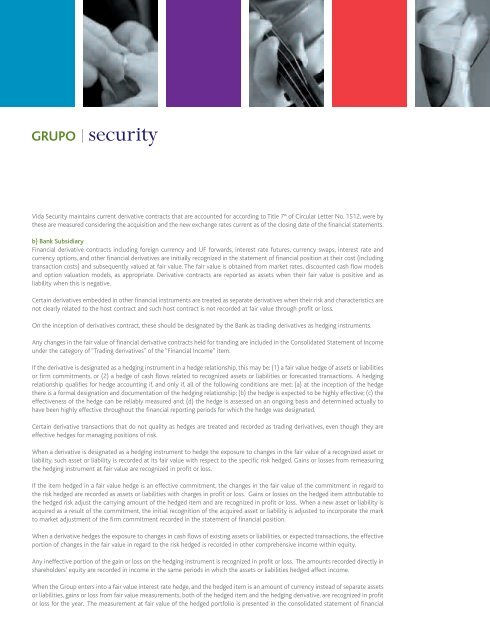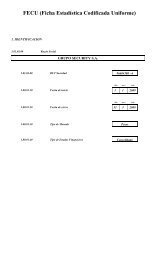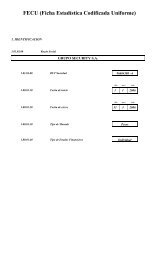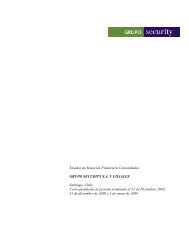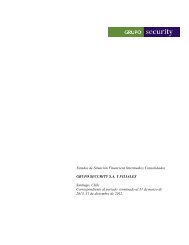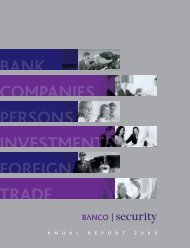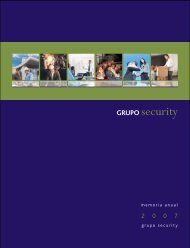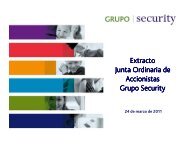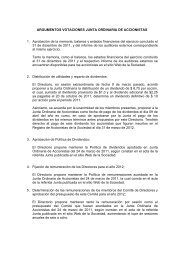PA - Banco Security
PA - Banco Security
PA - Banco Security
You also want an ePaper? Increase the reach of your titles
YUMPU automatically turns print PDFs into web optimized ePapers that Google loves.
Vida <strong>Security</strong> maintains current derivative contracts that are accounted for according to Title 7° of Circular Letter No. 1512, were by<br />
these are measured considering the acquisition and the new exchange rates current as of the closing date of the financial statements.<br />
b) Bank Subsidiary<br />
Financial derivative contracts including foreign currency and UF forwards, interest rate futures, currency swaps, interest rate and<br />
currency options, and other financial derivatives are initially recognized in the statement of financial position at their cost (including<br />
transaction costs) and subsequently valued at fair value. The fair value is obtained from market rates, discounted cash flow models<br />
and option valuation models, as appropriate. Derivative contracts are reported as assets when their fair value is positive and as<br />
liability when this is negative.<br />
Certain derivatives embedded in other financial instruments are treated as separate derivatives when their risk and characteristics are<br />
not clearly related to the host contract and such host contract is not recorded at fair value through profit or loss.<br />
On the inception of derivatives contract, these should be designated by the Bank as trading derivatives as hedging instruments.<br />
Any changes in the fair value of financial derivative contracts held for tranding are included in the Consolidated Statement of Income<br />
under the category of “Trading derivatives” of the “Financial Income” item.<br />
If the derivative is designated as a hedging instrument in a hedge relationship, this may be: (1) a fair value hedge of assets or liabilities<br />
or firm commitments, or (2) a hedge of cash flows related to recognized assets or liabilities or forecasted transactions. A hedging<br />
relationship qualifies for hedge accounting if, and only if, all of the following conditions are met: (a) at the inception of the hedge<br />
there is a formal designation and documentation of the hedging relationship; (b) the hedge is expected to be highly effective; (c) the<br />
effectiveness of the hedge can be reliably measured and; (d) the hedge is assessed on an ongoing basis and determined actually to<br />
have been highly effective throughout the financial reporting periods for which the hedge was designated.<br />
Certain derivative transactions that do not quality as hedges are treated and recorded as trading derivatives, even though they are<br />
effective hedges for managing positions of risk.<br />
When a derivative is designated as a hedging instrument to hedge the exposure to changes in the fair value of a recognized asset or<br />
liability, such asset or liability is recorded at its fair value with respect to the specific risk hedged. Gains or losses from remeasuring<br />
the hedging instrument at fair value are recognized in profit or loss.<br />
If the item hedged in a fair value hedge is an effective commitment, the changes in the fair value of the commitment in regard to<br />
the risk hedged are recorded as assets or liabilities with charges in profit or loss. Gains or losses on the hedged item attributable to<br />
the hedged risk adjust the carrying amount of the hedged item and are recognized in profit or loss. When a new asset or liability is<br />
acquired as a result of the commitment, the initial recognition of the acquired asset or liability is adjusted to incorporate the mark<br />
to market adjustment of the firm commitment recorded in the statement of financial position.<br />
When a derivative hedges the exposure to changes in cash flows of existing assets or liabilities, or expected transactions, the effective<br />
portion of changes in the fair value in regard to the risk hedged is recorded in other comprehensive income within equity.<br />
Any ineffective portion of the gain or loss on the hedging instrument is recognized in profit or loss. The amounts recorded directly in<br />
shareholders’ equity are recorded in income in the same periods in which the assets or liabilities hedged affect income.<br />
When the Group enters into a fair value interest rate hedge, and the hedged item is an amount of currency instead of separate assets<br />
or liabilities, gains or loss from fair value measurements, both of the hedged item and the hedging derivative, are recognized in profit<br />
or loss for the year. The measurement at fair value of the hedged portfolio is presented in the consolidated statement of financial


